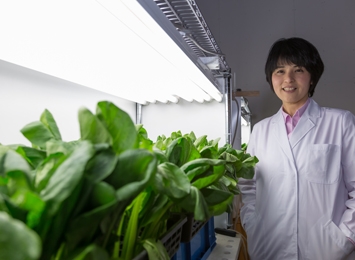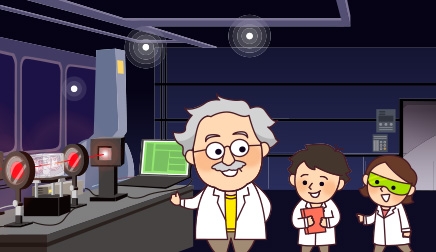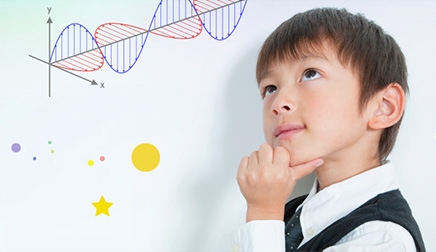 Home > Professor lights > Vol.01 Aya AKIKUSA
Home > Professor lights > Vol.01 Aya AKIKUSA
Vol.01 Aya AKIKUSA
Diagnose plant health with light the challenge to change the future of agriculture

Aya AKIKUSA
Lab No. 8, Hamamatsu Photonics
Central Research Laboratory
Profile Ms. Akikusa belongs to the agricultural group of the Hamamatsu Photonics Central Research Laboratory. She became interested in agriculture after learning about “dryland farming” in her high school days. As the research team leader, she is currently working on development of technology that is useful for future of agriculture, such as diagnosis of plant health and measurement of cultivation environment using optical sensing technology.
If we could check health of plants the same as getting a health exam then... There is a researcher who is working hard to develop the diagnosis of plants health which had been no easy feat even for veterans in this field.
That is a long way before putting the technology to practical uses yet the roadmap towards their goal seems to be clear.
Inspecting plant health condition from the component
Though the path is long, the goal is clear
Changing the future of agriculture with photonics technology

Inspecting plant health condition from the component
Plants which are said to be the first organisms to thrive on our planet have used light as an energy source since their born. Plants are also known to use light as a signal to detect the season for sprouting or blooming.
Here is a Professor Light who is working hard to explore the plants which are getting the great benefit of light.
Embracing the concept of “Life Photonics” the Hamamatsu Photonics Central Research Laboratory is throwing itself into the task of researching photonics to help the future of human beings. Here, Ms. Aya Akikusa is exploring possibilities of photonics in agriculture and more specifically using photonics for health diagnosis of plants.
She comments, “Just as we humans are warned about consuming too much salt or calories at a health exam, in the same way raising a healthy plant requires not giving them too much or too little fertilizer and water but making sure they get the water or fertilizer in exactly the right amounts. Plant bodies are comprised of vast amounts of water as well as carbohydrates, protein, and minerals but all those elements and their balance change during the development stage or depending on the condition of the plant. We are considering developing technology that allows us to follow up on changes in the water and essential elements within the plant body and estimating what kind of fertilizer or what kind of environmental element (water, light, temperature, etc.) is lacking or is in excess.”
The molecules that comprise the plant exhibit unique functions (or spectrum) by absorbing or reflecting light on a specific wavelength, so by applying various light wavelengths to the plant we can assume what molecules it contains in its body. And they are trying to put it to work in plant diagnosis.
“In recent years, a lot of cutting edge technologies such as smart farming and plant factories have been adopted in Japanese agriculture yet a large part of farming still depends on the five senses such as sense of touch and sight. Advances in IT mean that we can now utilize environmental data such as the temperature or humidity and amount of sunlight but the “skills to diagnose plant health” is an essential technology that we have not acquired yet. The “diagnostic skill” is a tacit knowledge accumulated by veteran farmers from intuition and over long years of experience. The fact that such special knowledge can no longer be easily passed onto future generations is likely one problem with current agriculture, right? I believe that by creating systems to allow sharing knowledge that anyone can easily understand, correctly and accurately finding the condition of plans, and making agricultural work more transparent, we can provide vital support for future agriculture.”

Though the path is long, the goal is clear
Ms. Akikusa has loved plants since she was a child. Through her school days she pursued whatever she found interesting at the time and future dreams sometimes came to mind but her bond with plants was always special.
“My oldest memory of having an interest in farming is a TV program that I watched in my high school days. I remember watching a special feature show on dryland farming where the water retentive property of material from paper diapers was utilized in growing farm products.” She commented that applying technical prowess to making the desert green was particularly impressive.
“In college, I majored in protected horticulture. There, I learned plant physiology and was fascinated by the fact that plant production could be greatly improved by optimizing the plant's physiology. I think my life is still an extension of those roots.”
The first encounter that Ms. Akikusa had with photonics technology was upon finding employment.
“I heard from someone that there was an interesting company starting to get into agriculture so I took their employment test and got my first exposure to photonics. Actually, at that time I knew next to nothing about photonics technology, ha-ha-.”
Currently Ms. Akikusa serves as leader of a research group developing measurement technology for plant growth environments and plant health diagnosis by analyzing plant elements through use of optical sensing technology. The group consists of 5 members. They have extensive backgrounds in a variety of areas other than botany such as genetics and physics, and machines. Together they are making a comprehensive effort ranging from research of the elemental technology to developing the actual device.
Ms.Akikusa quietly says, “Currently we are growing representative plants under controlled environment and establishing a database of numeric rating scales for plant parameters.” However the road until their work can be actually used at farm sites will not be an easy one.
The technology for diagnosing plant condition by optical sensing has mostly been established. However, the optimal numerical values differ depending on the type of plant and extent of growth so that just the task of gathering basic data of major plant types is already a hard work.
“Another goal is a development of devices. The current diagnostic approach is to utilize test devices such as spectrophotometers or high-speed liquid chromatography to analyze the fluid extracted from grinding up plants. These devices need to be handheld and easy to use with minimal sample preparation to be applicable for farmers.” She comments, “The unit practical for portable operation may be achieved by infrared spectrum technology currently under development though it is not yet in a size you could call handy.”
Though she modestly says, “I think personally that our current work has arrived at the first stage” one can see that progress is definitely being made and the eventual goal is in sight.

Changing the future of agriculture with photonics technology
How will photonics technology change the future of agriculture? Ms. Akikusa has a clear image of the change.
She further comments, “One future goal would be a development of handy plant diagnosis device that would be an indispensable item for farmers just as stethoscopes are a basic trademark of doctors.”
This would be a diagnostic tool capable of informing the user about plant health just by clamping it around a leaf or stem of the plant. Further, by also gathering and analyzing data on environment such as temperature and humidity, and a record of what task was performed at that time, this device could give instructions on the cultivating technique suitable for the area and weather, or selection of the ideal farm product to be cultivated. If that information could also be jointly shared by cloud or other means, then it would serve as a textbook for growing a full crop for farmers in the region, the country, and throughout the world. That is the future she can see.
She further comments, “Another great feature is that photonic analysis would allow nondestructive, noninvasive inspections typical of what you get from X-ray or MRI inspections. If we could make high-speed, high-sensitivity measuring instruments capable of remotely conducting analyses, then we might be able to estimate the health condition of plants over a vast area by utilizing artificial satellites and drones.” Ms. Akikusa and her team members started their current research 3 years ago which is certainly not a long period of experience.
“There are a number of other places where research in this field is in progress for applying optical sensing technology to agriculture. In this field we are still young researchers, but here we are receiving great support from senior researchers who have expertise in development of photonics technology.” The robustness of her team gives reality to her dream.
One source of enjoyment in her life is the time each day that she comes home, takes off her lab uniform, and returns to her life as a mother of three children at ages ranging from nursery school through an upper grade of elementary school.
Her eldest son is good at making a lunch box and baking sweets even though he is still in elementary school and she sometimes cooks along with him in the kitchen. She also enjoys challenging origami and handicraft with her second son, and reads alongside her third son who is a great fan of illustrated reference books. Staying alongside the kids while they do what they want to or must do is extremely important to her.
She says, “It may be out of place for me to say like this, but as a researcher, I have a huge goal of contributing to the world’s diet and helping to solve the world’s food problems. Yet I want to make the future of our children a lush green world where they can feel secure and don’t have to worry about the food they eat. That honestly sums up my feelings as a mother. In my case, those goals coincide with both my work and family and that makes me really happy and fulfilled.”






